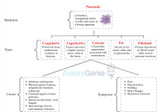Blog
Astrocyte Markers: A Guide
Explore the world of astrocytes, crucial star-shaped cells in the brain, and understand how specific markers help study their roles in neural health and disorders. Key Takeaways: Ast
…
25th Jun 2023
Hemocytometer Cell Counting Procedure
Understanding the Functionality of a Hemocytometer
Hemocytometers have bee
…
25th Jun 2023
Oligodendrocytes: What Are They?
Oligodendrocytes are pivotal CNS cells, integral for myelin formation and nerve function, with implications in various neurological disorders. Key Takeaways Oligodendrocytes are specia
…
22nd Jun 2023
Understanding Radial Glial Cells: Insights into Neurodevelopmental Processes
Radial glial cells are essential in shaping the nervous system, serving dual roles in neurogenesis and structural support during the brain's developmental stages. Key Takeaways: Radi
…
21st Jun 2023
A Guide To Tau Proteins & Tauopathies
Explore the essential role of Tau proteins in neuronal health and their impact in neurodegenerative diseases, unfolding the complexity behind their functions and dysfunctions. Key Takeaways:
…
21st Jun 2023
Growth Factors: Key Players in Biological Processes
Growth factors play a vital role in the complex web of biologi
…
20th Jun 2023
The PD-1 Pathway and Cancer Immunotherapy
The initial identification of PD-1 as a potential target for cancer treatment occurred in the late
…
20th Jun 2023
The Role of Zonulin In Intestinal Permeability
This article provides an overview of the protein Zonulin (function, structure, location). It describes tight junction proteins, leaky gut and Zonulin-related diseases. This includes celiac disease
…
18th Jun 2023
The Functions of Microglial Cells & Their Role in Neurodegenerative Disorders
Key Takeaways: Microglia are immune cells in the CNS, originating from myeloid precursor cells. They surveil the CNS, respond to changes, and maintain neural health. Microglia exist in diff
…
18th Jun 2023
The Gut Microbiome and Autoimmune Diseases: How Gut Bacteria Influence Immune Response
What are Autoimmune Diseases?
Autoimmune diseases are a diverse group of disorders where the immune system mistakenly attacks the body's own cells,
…
15th Jun 2023
Exploring Cellular Senescence: Defining Cell Morphology, Aging & Cell Division
Introduction Cellular senescence is a fascinating phenomenon that plays a crucial role in the aging process and various age-related diseases. It is essential to explore the cellular
…
14th Jun 2023
Stem Cells: What Are They and How They Can Help Treat Diseases
Stem Cells: What are they and how they can help treat diseases
Stem cells are a unique population of cells that possess the ab
…
12th Jun 2023
Oct-4 Stem Cells
Oct-4 stem cells, also known as Octamer-binding transcription factor 4 stem cells, are a fascinating area of study in the field of stem cell research. These stem cells hold great promise du
…
12th Jun 2023
Dendritic Cells - Markers, Activation & Subtypes
Exploring the multifaceted role of dendritic cells in immune function and disease. Key Takeaways DCs are professional antigen-presenting cells that capture, process, and prese
…
12th Jun 2023
Understanding Phosphorylation: From ATP Synthesis to Cellular Signaling
Introduction Phosphorylation is a fundamental biochemical process that plays a crucial role in various cellular functions. It involves the addition of a phosphate group to a molecule, typi
…
11th Jun 2023
Cytokine Storms: What happens when the immune system overreacts?
Discover the critical role of cytokines as signaling molecules in immune responses, their functions, and the impact of their dysregulation, including cytokine storms. Key Takeaways: Cy
…
11th Jun 2023
Polyclonal Vs Monoclonal antibodies: Key features
In the field of immunology and biomedical research, antibodies play a crucial role in identifying and targeting foreign substances in the body. However, not all antibodies are the same. In this bl
…
11th Jun 2023
Enhancing Cell Counting Accuracy with a Haemocytometer: A Comprehensive Guide
Cell counting is an important part of many different scientific experiments, enabling researchers to gather crucial data about cell populations and their characteristics. In this step-by-st
…
11th Jun 2023
The Blood Coagulation Pathway and related Disorders
Blood Coagulation Pathways Blood clotting, also known as hemostasis, is a fascinating and intricate process that ensures our bodies can effectively respond to injuries and prevent excessive
…
8th Jun 2023
What Is Gram Negative Bacteria & Why Can It Cause So Many Diseases
What is Gram-Negative bacteria? Gram-negative bacteria are a diverse group of microorganisms characterized by their unique cell wall structure. They stain pink or red when subjecte
…
8th Jun 2023
TNF alpha & Inflammation
Delving into TNF alpha's critical role in inflammation and its therapeutic targeting. Key Takeaways: TNF alpha is a crucial cytokine in inflammation and apoptosis. Its structure facilitat
…
8th Jun 2023
An Insight Into Necrosis- Causative Effects And Methods Of Prevention
What is Necrosis? Necrosis is a pathological process characterized by the death of cells or tissues within a living organism. It occurs as a result of various factors, including injury, infe
…
8th Jun 2023
Understanding Bone Resorption: Key Definitions and Processes
Unravel the complexities of bone resorption, a crucial biological process essential for skeletal health and calcium regulation, through the intricate roles of osteoclasts and osteoblasts. Ke
…
29th May 2023
Mycoplasma in Cell Culture Detection Guide
As a PhD student delving deep into the realm of cellular biology, there is one antagonist that consi
…
28th May 2023























